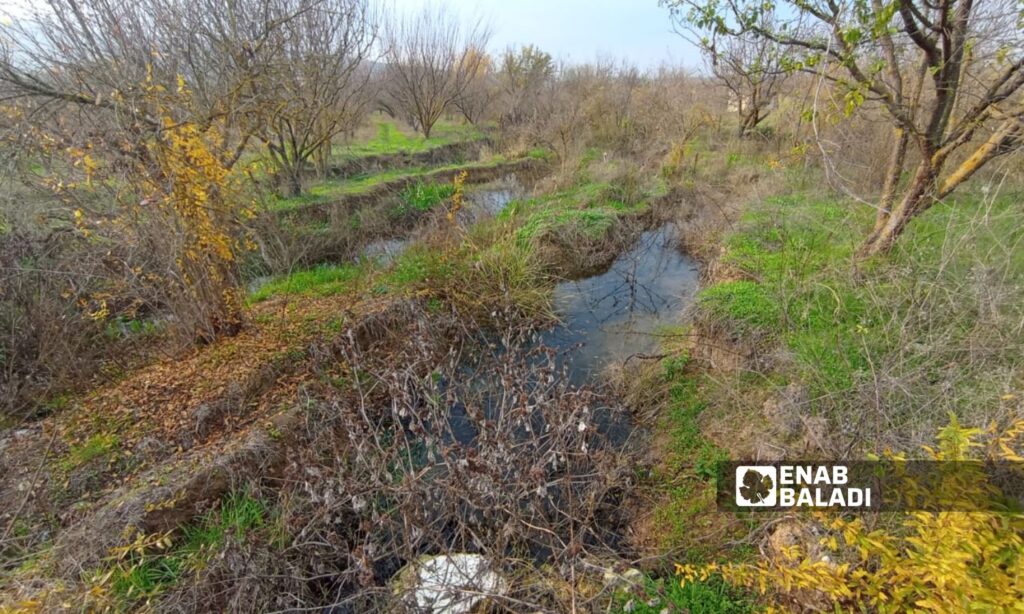Idlib – Anas al-Khouli
The fifty-something-year-old Ahmad al-Bakro carries large burlap bags filled with pomegranates on his back, transporting them over a distance of more than 500 meters due to the occurrence of large pits and soil collapses along the road connecting his land to his village of al-Alaniya near the city of Salqin, adjacent to the Turkish border.
These pits and cracks in the soil appeared following the earthquake that struck southern Turkey and four Syrian governorates on February 6 of the past year, and they still lack repairs.
Despite more than ten months passing since the earthquake, many roads remain out of service, and farmers find difficulties in accessing their agricultural lands, specifically the areas near the Turkish border.
500 meters are damaged
Al-Bakro told Enab Baladi that the pits appeared after the earthquake, and the diameter of each one reaches more than two meters, and they exist on the road connecting the agricultural lands and the village of al-Alaniya, known as the “Al-Assi Al-Atiq” or the “Old Assi” road.
According to al-Bakro, the length of the damaged distance of the road exceeds 500 meters, and this has hindered the farmers’ ability to access their lands using vehicles.
The people of the village of al-Alaniya have filed complaints with the local council in the area, as well as requests to the relevant organizations to repair the road before it is too late and to prevent the death of the trees from which they benefit. However, they only received a response from the Syria Civil Defense rescue agency, which worked on repairing the road for only two days and only managed to repair 50 meters of it.
Difficulties in transporting crops
The majority of the people of the village of al-Alaniya rely primarily on agriculture as a source of income, but the roughness of the road and their inability to bring in agricultural machinery such as tractors and cars has forced them to transport supplies and crops by carrying them on their backs.
Farmer al-Bakro said that he plants three crops in his land, which are peaches, greengage, and pomegranates, and he was not able to water the trees and take care of them this year. When harvesting the crops, the costs of transporting the crops within the damaged distance increased on top of the wages of the workers who helped him harvest the crops.
Al-Bakro pays 300 Turkish liras every day to the transport workers, who help him in carrying his produce, and he stated that it is a large amount that many farmers cannot afford. They rely on themselves to transport the crops and carry them on their backs.
Return to primitive means
The farmers’ inability to bring agricultural machinery to their lands has forced them to work using primitive means, such as plowing the land with old tools, despite the double effort and labor costs associated with it.
Another farmer, Imad al-Bakro, told Enab Baladi that the conditions of the road forced him to plow the land and take care of it using old tools and primitive plowing methods.
The most difficult challenges that the farmers face are the irrigation tasks carried out using very long water hoses connected to water tanks that reach the beginning of the damaged roads and are then extended to the agricultural lands over a distance of 500 meters, along with the fuel costs necessary to operate the pumps.
The farmer pointed out that irrigation is necessary to preserve the life of the trees until the road is repaired, stating that the delay in carrying out repairs will force the farmers to uproot the remaining trees, as they cannot continue to work with the old, exhausting, and costly primitive means.
Following the earthquake, the agricultural lands on the outskirts of the Orontes “Assi” River in northwestern Syria suffered soil collapses and cracks that created cavities of varying sizes, in addition to sand blows from underground.
Several agricultural lands in the city of Darkush in the western countryside of Idlib, located on both banks of the Orontes River, suffered landslides, and cracks emerged in the lands adjacent to the river, ranging in width from one to three meters and in depth from three to four meters.
Farmers from Darkush informed Enab Baladi that the fractures revealed new tunnels in the form of water channels, as well as the emergence of black sand from underground in bubble-like formations resembling a volcano.
Geophysical expert Ali al-Shaher told Enab Baladi at that time that the cracks that occurred on the outskirts of the Orontes River are referred to as local faults, running parallel to the course of the river, and these changes are known as “dangerous earthquake accompaniments.”

